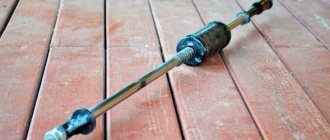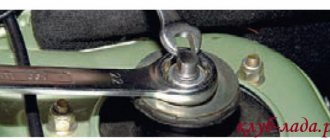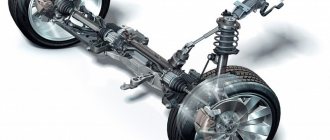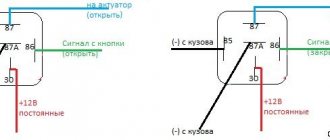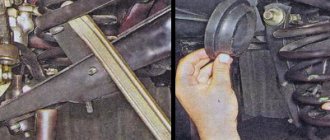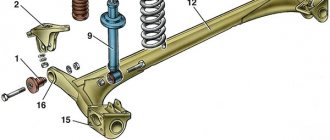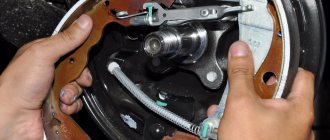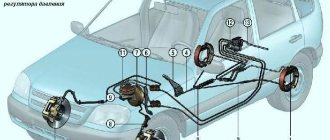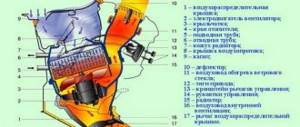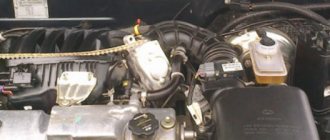Pros and cons of dependent car suspension
The design features of the suspension immediately lead us to the main plus and minus of this option. The downside is that it is not the highest level of comfort when driving on rough roads. When one wheel leans when driving over bumps, the other one also leans. In addition to the low level of comfort, the grip of the remaining wheels with the road surface is lost. A plus is smooth and stable cornering on flat roads.
Other disadvantages or disadvantages of dependent suspension include large unsprung masses and the importance of raising the floor of the car, which ensures full articulation of the suspension.
Important factors characterizing dependent suspension:
- Modern cars are not equipped with dependent suspension on the front axle. Most often, front dependent suspension is found on old SUVs, buses or trucks. In 99% of cases, the dependent suspension is installed on the rear axle.
- The dependent suspensions themselves differ in design and installation location.
Technical nuances
Now let’s move on to the technical side of the issue and understand the design and structure of the dependent system, as well as its varieties. Similar types of pendants include the following:
- on longitudinal springs (spring);
- with guide arms (dependent spring);
- De Dion pendant.
The first option is one of the oldest. This structure consists of a bridge beam connecting two wheels, as well as two longitudinal springs on which it is attached.
The spring in this embodiment acts as a universal elastic element - it takes on loads in the vertical and transverse planes, and also dampens body vibrations. Of course, you cannot achieve high comfort from the operation of the suspension of such a system, and at high speeds, problems with controllability begin to appear.
A design with guide arms can be called more advanced and modern. There are a lot of design options in terms of the number of levers and their configuration - this includes a suspension with a Panhard rod, and with a Watt or Scott-Russell mechanism. Compared to spring systems, these systems have much better handling and cornering behavior. The main elastic element here is the spring, and the shock absorber helps it.
As for the De Dion pendant, there is one nuance. The fact is that this system cannot be called completely dependent due to the tricky arrangement of the elements, which is due to the fact that it was developed for the rear axle of rear-wheel drive cars. In it, the differential and the beam connecting the wheels are separated.
We recommend: Tire pressure sensor: description, faults, types, photos
The differential is rigidly connected to the car body, and rotation from it to the wheels is transmitted through swinging drive shafts. According to experts, the De Dion suspension is superior in many respects to the best examples of independent designs, and its only significant drawback is the price, which is why you can rarely see it, and even then mainly on sports cars.
Pros and cons of independent car suspension
The main advantage of independent suspensions is that a wheel that runs over an uneven surface does not affect the position of the second wheel. This ensures comfort while driving and even grip on the road surface on uneven areas.
Another important advantage is the reduced unsprung masses. They are already smaller than in dependent suspensions, but they can be even smaller thanks to the use of modern materials. The disadvantages include the constant change in camber and wheel track width.
Interestingly, independent suspensions can be of different designs. These can be longitudinal, oblique, transverse, multi-link, pneumatic, hydropneumatic and active suspensions. Also, independent models can be equipped with special shock absorbers, filled with liquids, etc.
The main purpose of independent suspensions is to guarantee driving comfort and stable vehicle handling.
Incomplete independence: how it works and what is good about semi-independent suspension
How independent is independent suspension?
It would seem that since the suspension is independent, the movement of one wheel does not depend in any way on the other.
This is more common in theory. In practice, completely independent suspensions are a rarity. Almost always, the suspension design includes such a part as an anti-roll bar. Thanks to it, the vertical movements of one wheel are transmitted through an elastic torsion bar to the other. Such a “violation of independence” is necessary to improve the car’s handling, or more precisely, to reduce roll in corners. The solution is not the most elegant, and has a number of disadvantages, but it is inexpensive, because active suspensions are orders of magnitude more expensive. And so a fairly simple detail prevents the car from falling over in a turn.
Of course, the handling can be adjusted without this part, and even the smoothness of the ride will improve. There are many examples of this: Renault Logan, for example, after the first restyling, lost a stabilizer in the front, while classic Zhiguli cars never had one in the rear suspension. But most modern cars have it in both the front and rear suspensions.
Pictured: Renault Logan '2004–09
It’s not uncommon to have “active” stabilizers that can change the angular stiffness of the torsion bar or turn it off altogether. These exist, for example, on BMW cars or Nissan SUVs. This allows you to reduce the negative factors from using a stabilizer.
Pictured: Nissan Patrol '2014–present.
It turns out that the suspensions of the vast majority of cars are not completely independent; the movement of one wheel still causes the movement of the other. Albeit to a lesser extent than in the presence of a connection in the form of a common rigid axis, like a dependent suspension, when the movement of one wheel is always uniquely related to the movement of the second.
By the way, with continuous axles, a stabilizer bar is also used: cars with any suspension have rolls.
Semi-dependent: rare and most common
Articles / Used Audi A6 C4 sedan: the pros of thick steel and the cons of complex electrics While working on the review of the Audi 100 C4, I planned to devote at most a few paragraphs to its successor, the A6 C4. But the deeper I dived into the technical features, the clearer it became that this was... 16512 1 0 03/01/2017
If a stabilizer is still needed, then maybe it can be made part of the supporting structure of the suspension? This is probably exactly what the engineers thought when they came up with the MacPherson front suspension for the Audi 100/A6 in the C4 body . Don’t be surprised, but her MacPherson is semi-independent, because instead of the front lower suspension arm, it uses a powerful anti-roll bar. Both wheels are connected by a single elastic part, which is part of the supporting structure. The eighties were generous with interesting technical solutions, so I wouldn’t be surprised if some other machines used a similar scheme, because the stabilizer torsion bar is very convenient to use as a lever. In terms of kinematics, the Audi suspension can be considered completely independent, with one significant “but”: the vertical movement of one of the wheels necessarily causes the movement of the second wheel by a significant amount, associated with a fairly high rigidity of the torsion bar.
A very common semi-independent suspension design with a torsion beam is also the result of the efforts of Volkswagen engineers. After all, it appeared on the VW Golf in 1974. The genius of the idea was that here the guide apparatus of both rear wheels was a single part, which was attached to the body at only two points. And the elastokinematics of movement of each of the wheels was almost similar to the kinematics of the suspension on the trailing arms. The H-shaped beam is attached to the body at two extreme points, and the wheel hubs are located at the lower ends of the letter. The most important part of the structure is the cross member, which connects the structure together and provides the necessary rigidity. If the beam is positioned close to the attachment points to the body (when the beam turns into the letter P), then the suspension according to the kinematic diagram will be completely similar to the design on trailing arms, and if moved closer to the attachment points of the wheels, it will be more similar to dependent suspensions. The central part of the beam in this design is necessarily flexible and can bend, providing the wheels with the ability to move independently. Such a suspension can be classified as dependent only structurally: the wheels are connected by a single part of the supporting structure. But in operation such a suspension is still similar to independent ones.
Pictured: Volkswagen Golf '1974–83
The design is so convenient for mass automotive production that it is used for cars up to class D inclusive , and sometimes used in combination with a driven rear axle. For example, on the Opel Mokka crossover there is a twisted H-shaped beam at the rear, even on versions with all-wheel drive.
The secret of such success is simple. Firstly, the design is extremely reliable: powerful side arms are connected by a powerful torsion bar, and it is attached to the body with large and durable silent blocks. These parts last a long time and are difficult to break. And this design is inexpensive both to manufacture and to operate.
The kinematics of wheel movement is initially successful and can vary widely by changing the rigidity of the fastenings, the rigidity of the torsion bar, the side arms and their relative position. In addition, the suspension is very compact, allowing the shock absorbers to be spaced as wide as possible, which ensures excellent operating conditions. The springs and shock absorbers can be positioned very low and tightly, which increases the internal volume of the rear of the car. Of all types of independent suspensions for non-driving wheels, only multi-link designs based on double-wishbone suspensions or MacPherson struts have the best kinematics, but they are much more expensive.
This scheme also has disadvantages. The elastokinematics of an H-shaped beam is such that the angular stiffness of the beam is always related to the lateral compliance of the suspension and the load. As a result, the beam is always too stiff for its role as an anti-roll bar. The unsprung masses of this type of suspension are also quite high, and an attempt to reduce the mass of the beam by reducing the length of the trailing arms leads to a deterioration in the kinematics of its operation and an increase in the rigidity of the connection. And it is also structurally difficult to decouple the rigidity of rubber-metal elements in the longitudinal and transverse directions; they will always be connected, because these are just two silent blocks that work against torsion and rupture.
Complicating the design by introducing jet thrust, for example, in the form of the Watt mechanism, is not a new move. More recently, it was used in mass production on the Opel Astra J/Chevrolet Cruze, and athletes, when preparing cars with an H-shaped beam, often used additional reaction arms to improve handling and control kinematics.
Watt mechanism
They try to place the supporting elements of the beam at an angle to the rolling plane of the beam: this ensures a reduction in the transmission of vibrations to the body while reducing the compliance of the blocks in the transverse direction and improving the kinematics. Additional tricks in the form of moving the spring support areas to external brackets make it possible to ensure the required wheel rotation angle under load. But in any case, this type of suspension remains structurally simple and cheap. And that is why it is used so widely.
How is it in practice?
Comparing different cars with different types of rear suspension does not make it possible to choose a clear leader. Of course, it is easier to provide a multi-link suspension with good handling and high ride comfort combined with a high load capacity. But here’s the problem: even when comparing cars of the same class, it is impossible to draw a conclusion about what kind of suspension is used only on the basis of their driving characteristics. A real gift for those who like to find out what is better and what is worse are cars on the MQB platform: many of them, depending on the engine, can use either a beam or a multi-link design in the rear suspension.
My personal experience shows that only a serious comparison allows one to reveal the nuances, and in normal operation one can only notice a slightly different acoustic picture when driving over uneven surfaces and a more obvious change in handling under load in cars with an H-shaped torsion beam compared to cars with a multi-link suspension. Blind comparisons usually do not provide a clear winner. And all this suggests that manufacturers’ enthusiasm for this type of suspension on budget cars is quite justified: for the price of an inexpensive dependent suspension, you get a full-fledged independent suspension with good kinematics.
Survey
What kind of suspension does your car have?
Your voice
Total votes:
Which suspension is better - dependent or independent?
It is best to consider in advance where and how the car will be used, since the choice of suspension type depends on this.
Dependent suspensions are simpler and cheaper to maintain, but they cannot provide sufficient comfort and high controllability.
Independent suspensions are a little more complex in terms of design, but they are much more comfortable to use.
Naturally, repairs of the first type will be slightly cheaper than servicing independent models
